First to the fight is a bad place to be.
With IEDs set on the side of the road, or attacks springing suddenly from concealed attackers in ambush, being first is a risky proposition. Which means it’s an ideal job for a robot, immune from such fleshy concerns as panic or mortality.
Last month, U.S. Army Tank Automotive Research, Development and Engineering Center (TARDEC) and the U.S. Army Armaments Research, Development and Engineering Center (ARDEC) collaborated to see if a robot Humvee could do the same course as human crews.
That course was Scout Gunnery Table VI, which the Army uses to certify crews for combat vehicles. The course tests the vehicle’s ability to move and shoot and communicate, engage stationary and moving targets. Those targets range from infantry cut-outs to armored vehicle silhouettes. For testing a robotic Humvee, the Army will send it alongside a human-driven command-and-control vehicle, as a sort of wingman team. The robot Humvee will operate without people inside, using three different autonomous systems:

First is the TARDEC-developed Robotic Technology Kernel (RTK), the autonomy system for planning and controlling the vehicle’s mobility. RTK contains driving cameras for remote operation, LIDAR (light detection and ranging) sensors for object classification, stereo cameras for terrain classification, computers for computation, radios for communication, and all the essential hardware, cables and mounts. The system can be manually driven through teleoperation or autonomously driven through waypoint navigation.
In addition to the autonomy system, the robotic vehicle has a Picatinny Lightweight Remote Weapon System that can mount either a minigun or a machine gun. That means that this is an armed robot, though one with a human-in-the-loop, as we’ll get to in just a moment. The robot Humvee, with its autonomy system and remote weapon system, also uses the Autonomous Remote Engagement System (ARES), which, according to the Army can, uses a vision-based system to both track targets on its own and follow targets designated by a human user.
So, this is a Humvee that can be remotely controlled or navigate autonomously to waypoints, that mounts a weapon, and that can watch and track targets. Crucially, it takes a human to press the trigger. In this case, that human is one of the five people in the wingman command-and-control vehicle. There’s a commander, a driver and then, in the back, there’s a gunner and a remote driver (piloting the robot) and a remote weapons operator (controlling the robot’s gun). The hatch gunner can also use a designator to mark targets for the robot.
The autonomy we see here is a sort of limited, directed autonomy: the robot can go where it’s sent, and point a gun at a target it’s told to follow, but this is not a machine operating entirely independently, given a mission it then executes on its own. Instead, it is a robot tag-along, a vehicle crewed remotely.
As robotics move more and more into the battlefield and become a standard part of war, it will look a lot like this: an aging military machine, retrofitted into a robot, taking point on patrol and firing back while a human, inside a follow-on vehicle, tells the robot what to shoot.
Kelsey Atherton blogs about military technology for C4ISRNET, Fifth Domain, Defense News, and Military Times. He previously wrote for Popular Science, and also created, solicited, and edited content for a group blog on political science fiction and international security.







